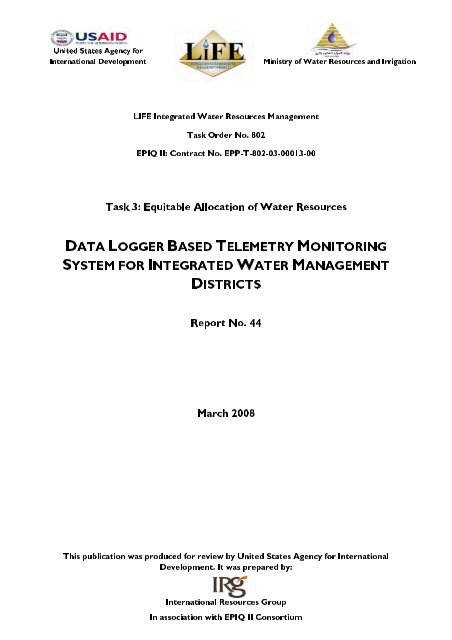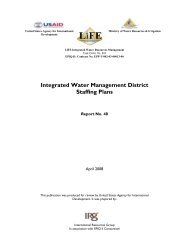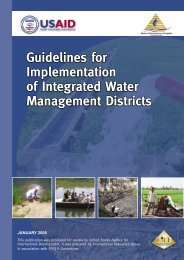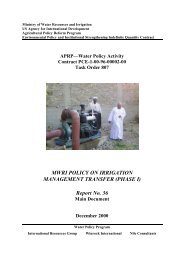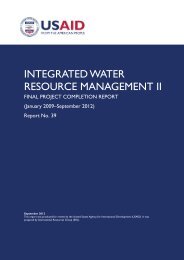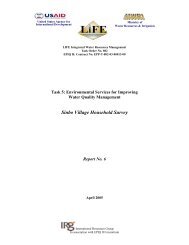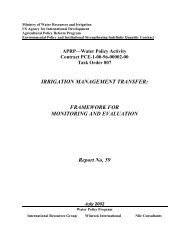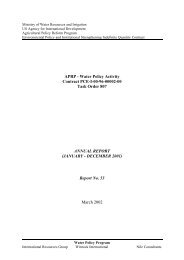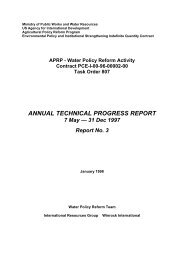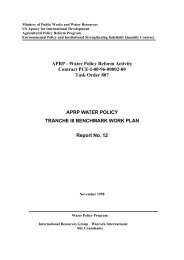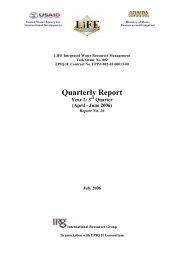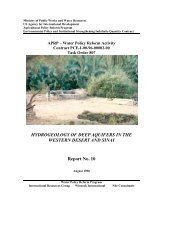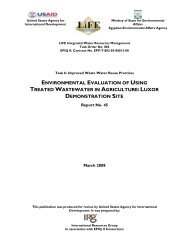Report 44 Task 3 Data Logger Telemetry System
Report 44 Task 3 Data Logger Telemetry System
Report 44 Task 3 Data Logger Telemetry System
Create successful ePaper yourself
Turn your PDF publications into a flip-book with our unique Google optimized e-Paper software.
publication was produced for review by United States Agency for International<br />
This<br />
It was prepared by:<br />
Development.<br />
United States Agency for<br />
International Development<br />
Ministry of Water Resources and Irrigation<br />
LIFE Integrated Water Resources Management<br />
<strong>Task</strong> Order No. 802<br />
EPIQ II: Contract No. EPP-T-802-03-00013-00<br />
<strong>Task</strong> 3: Equitable Allocation of Water Resources<br />
DATA LOGGER BASED TELEMETRY MONITORING<br />
SYSTEM FOR INTEGRATED WATER MANAGEMENT<br />
DISTRICTS<br />
<strong>Report</strong> No. <strong>44</strong><br />
March 2008<br />
International Resources Group<br />
In association with EPIQ II Consortium
US Agency<br />
Ministry of Water Resources<br />
and Irrigation<br />
for International Development<br />
LIFE Integrated Water Resources Management<br />
<strong>Task</strong> Order No. 802<br />
EPIQ II: Contract No. EPP-T-802-03-00013-00<br />
<strong>Task</strong> 3: Equitable Allocation of Water Resources<br />
DATA LOGGER BASED TELEMETRY MONITORING<br />
SYSTEM FOR INTEGRATED WATER MANAGEMENT<br />
DISTRICTS<br />
<strong>Report</strong> No. <strong>44</strong><br />
Prepared by:<br />
Eng. Ibrahim Mahdy Sallam<br />
Eng. Ayman ElSayed Ibrahim<br />
March 2008<br />
DISCLAIMER<br />
The authors views expressed in this publication do not necessarily reflect the views of the United<br />
States Agency for International Development or the United States Government
of Figures and Tables...........................................................................................................ii<br />
List<br />
Figures...................................................................................................................................................................ii<br />
<strong>Data</strong> Summary..................................................................................................................... 4<br />
4.<br />
Preparation and Equipment ......................................................................................................................5<br />
Site<br />
Lesson Learned .................................................................................................................. 15<br />
8.<br />
of Operation Policy at Mealla Pump Station.............................................................................. 15<br />
Revision<br />
Policy Evaluation at East Menofiya Pump Station.................................................................. 15<br />
Operation<br />
<strong>Data</strong> and Downstream Sites .................................................................................................... 16<br />
Monitoring<br />
to Integrated Water Management and Conflict Resolution.................................................. 16<br />
Supports<br />
<strong>Data</strong> Supports Planning .................................................................................................................... 17<br />
<strong>System</strong><br />
Supports Ministry’s Plans for the <strong>Telemetry</strong> <strong>System</strong> ................................................................. 17<br />
<strong>System</strong><br />
Supports Integrated Water Management during Crises ........................................................... 17<br />
<strong>System</strong><br />
Confidence of the <strong>System</strong> .................................................................................................................... 17<br />
High<br />
Supports Water Quality Management and Drainage Water Reuse ....................................... 17<br />
<strong>System</strong><br />
1 <strong>Logger</strong> Net Software Operation ..................................................................... 27<br />
Annex<br />
Net Setting .......................................................................................................................................... 27<br />
<strong>Logger</strong><br />
GSM Modem Connection............................................................................................................... 29<br />
SAMBA<br />
of TANGO GSM Modem with CR510 <strong>Logger</strong>................................................................... 30<br />
Connection<br />
3 Maintenance Forms ......................................................................................... 37<br />
Annex<br />
<strong>Logger</strong> Scheduled Maintenance Form................................................................................................ 37<br />
<strong>Data</strong><br />
Modem Maintenance Form ............................................................................................................... 39<br />
Tango<br />
Supply Scheduled Maintenance Form............................................................................................. 40<br />
Power<br />
<strong>Task</strong> 3. <strong>Data</strong> <strong>Logger</strong> Based <strong>Telemetry</strong> Monitoring <strong>System</strong><br />
TABLE OF CONTENTS<br />
Tables ....................................................................................................................................................................ii<br />
Acronyms and Abbreviations....................................................................................................iii<br />
1. Introduction ......................................................................................................................... 1<br />
2. Implementation Strategy ................................................................................................... 2<br />
3. Pilot Project Sites................................................................................................................ 3<br />
5. <strong>Data</strong> Management ............................................................................................................. 10<br />
6. <strong>System</strong> Evaluation ............................................................................................................. 13<br />
7. <strong>System</strong> Benefits ................................................................................................................. 14<br />
9. <strong>System</strong> installation and Operation Cost......................................................................... 18<br />
10. Problems Encountered ..................................................................................................... 19<br />
11. Site Photos ......................................................................................................................... 20<br />
12. Recommended Preventive Maintenance Schedule ....................................................... 24<br />
13. Recommendations and Future Plan ................................................................................ 26<br />
Annex 2 <strong>Logger</strong> NET ....................................................................................................... 31<br />
LIFE IWRM i INTERNATIONAL RESOURCES GROUP
<strong>Task</strong> 3. <strong>Data</strong> <strong>Logger</strong> Based <strong>Telemetry</strong> Monitoring <strong>System</strong><br />
LIST OF FIGURES AND TABLES<br />
Figures<br />
Figure 1 Installed Monitoring Components....................................................................................... 5<br />
Figure 2 Remote <strong>Data</strong> <strong>Logger</strong> Sites in Qena Directorate ............................................................. 6<br />
Figure 3 <strong>Data</strong> <strong>Logger</strong>s Sites in West and East Sharkiya Directorates......................................... 7<br />
Figure 4 <strong>Data</strong> <strong>Logger</strong> Sites in Zifta Directorate ............................................................................... 8<br />
Figure 5 <strong>Data</strong> <strong>Logger</strong> Sites in Aswan Directorate ............................................................................... 9<br />
Figure 6<br />
User Main Menu.....................................................................................................................11<br />
Figure 7 MIMIC Display for Mealah PS <strong>Data</strong> ...................................................................................12<br />
Figure 8 Table Displaying Mealah PS <strong>Data</strong> .......................................................................................12<br />
Figure 9 Downstream Water Levels, Meaala PS, 11 June–17 July, 2007......................................15<br />
Figure 10 East Menofiya PS Upstream Water Level and Conductivity, 17–21 July, 2007........16<br />
Figure 11 Ghawasa Regulator USWL & DSWL, 25 June–5 July 2007...................................16<br />
Figure 12 Meit Bera Regulator .........................................................................................................20<br />
Figure 13<br />
Meit Bera Regulator’s <strong>Data</strong> <strong>Logger</strong> and GSM Modem Connection with RTU.21<br />
Figure 14 Meala PS Relay Enclosure, <strong>Data</strong> <strong>Logger</strong> and GSM Modem Connection .............21<br />
Figure 15 Meala PS Local Warning <strong>System</strong> and Installed Siren ................................................22<br />
Figure 16 Ghawasa Regulator Installed Equipment .....................................................................22<br />
Figure 17 Ghawasa Regulator Installed Sensor Pipes .................................................................23<br />
Tables<br />
Table 1<br />
Monitored <strong>Data</strong> by Location............................................................................................................4<br />
Table 2<br />
Recommended Maintenance Schedule........................................................................................24<br />
LIFE IWRM ii INTERNATIONAL RESOURCES GROUP
<strong>Task</strong> 3. <strong>Data</strong> <strong>Logger</strong> Based <strong>Telemetry</strong> Monitoring <strong>System</strong><br />
ACRONYMS AND ABBREVIATIONS<br />
DO<br />
Dissolved Oxygen<br />
DSWL Downstream Water Level<br />
GMS<br />
Global <strong>System</strong> for Mobile communications<br />
GPRS<br />
General Packet Radio Service<br />
IP<br />
Internet Provider<br />
IWMD Integrated Water Management District<br />
km<br />
Kilometer<br />
LE<br />
Egyptian Pounds (currency)<br />
LIFE<br />
Livelihood and Income from the Environment (Project)<br />
MIMIC Display Panel<br />
MWRI Ministry of Water Resources and Irrigation<br />
PDA<br />
Personal Digital Assistant (computing)<br />
pH<br />
Measure of acidity or alkalinity<br />
PS<br />
Pumping Station<br />
RTU<br />
Remote Terminal Unit<br />
SMS<br />
Short Message Service<br />
USAID United States Agency for International Development<br />
USWL Upstream Water Level<br />
VHF<br />
Very High Frequency<br />
LIFE IWRM iii INTERNATIONAL RESOURCES GROUP
document describes the pilot project for implementing a data logger-based telemetry system to<br />
This<br />
inflows and outflows of the Integrated Water Management Districts (IWMDs). The main<br />
monitor<br />
of the implemented pilot project was to strengthen the capabilities of the IWMDs’<br />
purpose<br />
staff to monitor and analyze water. distribution The system was implemented at eleven<br />
operations<br />
structures and pumping stations. At irrigation structures, the system provided real or near<br />
irrigation<br />
time information on water levels and flows. At the pumping stations, in addition to monitoring<br />
real<br />
level data, the system monitored changes in pump status, operating hours, and flow. The pilot<br />
water<br />
included monitoring water quality parameters (pH, conductivity, and dissolved oxygen) at<br />
project<br />
sites. Moreover, a local warning system was included in the pilot project at one pumping<br />
some<br />
site, in addition to a short message service- (SMS) based warning system.<br />
station<br />
data will help in calculating water flow volumes at major inflow and outflow points, in order to<br />
The<br />
water quotas for each district and achieve enhanced water management. Having these data<br />
monitor<br />
in real time will be of great benefit in achieving integrated water management. The system<br />
available<br />
data loggers equipped with GSM modems at irrigation structures and pumping stations. The data<br />
uses<br />
<strong>Task</strong> 3. <strong>Data</strong> <strong>Logger</strong> Based <strong>Telemetry</strong> Monitoring <strong>System</strong><br />
1. INTRODUCTION<br />
can be downloaded at IWMDs offices using another GSM modem.<br />
LIFE IWRM 1 INTERNATIONAL RESOURCES GROUP
order to minimize the capital cost, the Ministry of Water Resources and Irrigation’s (MWRI)<br />
In<br />
telemetry network was utilized to serve this pilot project. The MWRI already has a<br />
existing<br />
system that monitors water level data and uses VHF as the communication media. The<br />
telemetry<br />
is complicated in its structure. Moreover, the performance of this old system is not<br />
system<br />
partly due to the long path of data, VHF interference, and faulty equipment at the end of<br />
satisfactory,<br />
useful life.<br />
its<br />
pilot system uses the existing infrastructure of the telemetry network. The existing water levels,<br />
The<br />
conduits, batteries, solar panels, solar regulators, and civil construction were used following<br />
cables,<br />
maintenance. A data logger with sufficient input and output was connected to water level<br />
minor<br />
The solar panel and battery were used to provide continuous power to the low power<br />
sensors.<br />
data logger. The new equipment, data logger, and GSM modem were installed inside<br />
consumption<br />
same box from the existing telemetry system.<br />
the<br />
existing water level sensors were connected to the data logger. The data logger continuously<br />
The<br />
measured data from the sensors. This data could be provided to any remote location in a real<br />
read<br />
sense. The data logger also stored measured data according to predefined intervals with a<br />
time<br />
of 1 minute. The stored data could be downloaded remotely at any time by the GSM<br />
resolution<br />
The time resolution used in this project was an hour, which meant that data loggers stored<br />
network.<br />
readings from all sensors and saved the data to a file.<br />
hourly<br />
pilot project achieved another important planned objective related to evaluating MWRI plans to<br />
The<br />
the existing telemetry system. The Ministry, with support from the United States Agency<br />
renovate<br />
International Development (USAID), invested a lot of money in the telemetry network in early<br />
for<br />
USAID supplied US$56 million to implement the network throughout the country’s irrigation<br />
1990s.<br />
Recently the performance of the telemetry system became unsatisfactory and its support<br />
networks.<br />
water management was diminishing. The Ministry has been studying renovating approaches to get<br />
to<br />
system in service again to make use of the earlier investment. The pilot showed that the existing<br />
the<br />
can be renovated at a very small capital investment.<br />
network<br />
equipment was chosen to achieve reliable operation and accuracy, be low in power<br />
The<br />
and be compatible with the latest technologies in the field of communication and<br />
consumption,<br />
systems. <strong>System</strong> features include accuracy, simplicity, reliability, and flexibility. Accuracy<br />
electronic<br />
achieved as a result of precise data logger acquisition capability. The compact size of the<br />
was<br />
and its ease of use make the system simple. Reliability is achieved with the outstanding<br />
equipment<br />
and low power consumption of the data logger. The flexibility of the system operation<br />
performance<br />
different ways to collect data. The data stored hourly could be collected using three different<br />
allows<br />
methods:<br />
Direct connection, using a Personal Digital Assistant (PDA) or laptop computer<br />
•<br />
Using a memory module<br />
•<br />
Remotely, using a GSM modem.<br />
•<br />
could be monitored and collected from any IWMD or irrigation directorate office using a GSM<br />
<strong>Data</strong><br />
network. During the past years, the system gave excellent performance and<br />
communication<br />
accurate measures of water levels and flows. The stored and collected data is useful not<br />
provided<br />
for daily system operation but also for system planning. Operation policies for irrigation<br />
only<br />
are being revised based on these data. The water level monitoring network ensures that<br />
structures<br />
needs are met. The data collected at pumping stations helped to solve conflicts between the<br />
water<br />
<strong>Task</strong> 3. <strong>Data</strong> <strong>Logger</strong> Based <strong>Telemetry</strong> Monitoring <strong>System</strong><br />
2. IMPLEMENTATION STRATEGY<br />
irrigation directorates and the mechanical and electrical directorates.<br />
LIFE IWRM 2 INTERNATIONAL RESOURCES GROUP
sites of the pilot project were carefully selected. All the sites are critical and have a major effect<br />
The<br />
water management, with an essential need for monitoring near real time data as most of them<br />
on<br />
water distribution problems. The site selection criteria helped in evaluating the<br />
encounter<br />
of the system and identifying achieved goals. At all selected sites the upstream and<br />
performance<br />
water levels and water flows are monitored. Water quality parameters are monitored<br />
downstream<br />
two sites. The pump monitoring system was installed at two sites. The pilot project is<br />
at<br />
Abou el-Akhadr Regulator<br />
•<br />
Meit Bera Regulator<br />
•<br />
Meluig Regulator<br />
•<br />
Hebeil Regulator<br />
•<br />
El-Ghawasa Regulator<br />
•<br />
Ismailia Intake<br />
•<br />
Mealaa Pumping Station (PS)<br />
•<br />
East Menofiya PS<br />
•<br />
El Selsala PS.<br />
•<br />
Daraw Regulator<br />
•<br />
GSM mobile communication network provided flexibility for data collection. <strong>Data</strong> can be<br />
The<br />
from any remote location provided that it is covered by the mobile network. The data<br />
collected<br />
be collected at the irrigation directorate office, or a water distribution engineer could use a<br />
might<br />
to collect data in the field. For now, the data are monitored at different levels from the<br />
laptop<br />
Berket el-Saab IWMD<br />
•<br />
Luxor IWMD<br />
•<br />
Zifta General Directorate<br />
•<br />
East Sharkiya General Directorate<br />
•<br />
West Sharkiya General Directorate<br />
•<br />
East Qena General Directorate<br />
•<br />
Aswan Directorate.<br />
•<br />
Aswan IWMD<br />
•<br />
Lower Egypt Water Distribution Directorates at Tanta<br />
•<br />
Central Directorate for <strong>Data</strong> Collection and Communication <strong>Telemetry</strong><br />
•<br />
The Livelihood and Income from the Environment (LIFE) Integrated Water<br />
•<br />
<strong>Task</strong> 3. <strong>Data</strong> <strong>Logger</strong> Based <strong>Telemetry</strong> Monitoring <strong>System</strong><br />
3. PILOT PROJECT SITES<br />
at the following sites:<br />
implemented<br />
Kilometer (km) 24 on Mous Regulator<br />
•<br />
locations:<br />
following<br />
Quesna IWMD<br />
•<br />
• El Selsala IWMD<br />
• Central Directorate for Water Distribution at the MWRI Building<br />
Resources Management Project.<br />
LIFE IWRM 3 INTERNATIONAL RESOURCES GROUP
<strong>Task</strong> 3. <strong>Data</strong> <strong>Logger</strong> Based <strong>Telemetry</strong> Monitoring <strong>System</strong><br />
4. DATA SUMMARY<br />
The monitored data includes water levels and water flows, pump status (On/Off), and pump<br />
operating hours. The water quality parameters measured and monitored include pH, dissolved<br />
oxygen, and conductivity. Table 1 describes data monitored by the system at each site:<br />
Table 1<br />
Monitored <strong>Data</strong> by Location<br />
Site Directorate Monitored <strong>Data</strong><br />
km 24 Regulator<br />
East Sharkiya<br />
Upstream Water Level (USWL) –<br />
Downstream Water Level (DWSL) –<br />
West Sharkiya<br />
Water Flow<br />
Abou el-Akhdar<br />
East Sharkiya<br />
USWL-DWSL – Water Flow<br />
Regulator<br />
West Sharkiya<br />
Meit Bera Regulator<br />
Zifta Directorate<br />
USWL-DWSL – Water Flow<br />
Quesna IWMD<br />
Meluig Regulator<br />
Zifta Directorate<br />
USWL-DWSL – Water Flow<br />
Berkt el-Sabaa IWMD<br />
Hebeil Regulator<br />
Qena Directorate<br />
USWL-DWSL – Water Flow<br />
Luxor IWMD<br />
Ghawasa Regulator Qena Directorate USWL-DWSL – Water Flow<br />
Ismailia Intake WD Central Directorate USWL-DWSL – Water Flow – pH –<br />
Dissolved Oxygen (DO) - Salinity -<br />
Water & Air Temperatures<br />
East Menofiya PS<br />
Zifta Directorate<br />
USWL-DWSL – Water Flow – Pump<br />
Status (On/Off) - Pump Operating<br />
Berkt el-Sabaa IWMD<br />
Hours – pH - DO-Salinity – Water & Air<br />
Temperatures<br />
Mealla PS<br />
Qena Directorate<br />
USWL-DWSL-Flow – Pump Status<br />
(On/Off) – Pump Operating Hours<br />
Luxor IWMD<br />
EL Selsala PS<br />
Aswan Directorate<br />
USWL-DWSL-Flow – Pump Status<br />
(On/Off) – Pump Operating Hours<br />
El Selsala IWMD<br />
Daraw Regulator<br />
Aswan Directorate<br />
USWL-DWSL – Water Flow<br />
Aswan IWMD<br />
In additional to the collected data, the pump monitoring system also provides an automatically<br />
activated local/remote warning system in some circumstances. The local warning system has a siren<br />
installed at the pumping station; the remote system is implemented by a GSM SMS. The warning<br />
system is activated if all pumps in a pumping station are switched off.<br />
LIFE IWRM 4 INTERNATIONAL RESOURCES GROUP
• <strong>Data</strong> logger, which serves as the data acquisition system to read sensors hourly,<br />
• GSM/GPRS modem, used for data communication to the site<br />
GSM<br />
Modem<br />
WIRELESS<br />
TELEPHONE<br />
<strong>Task</strong> 3. <strong>Data</strong> <strong>Logger</strong> Based <strong>Telemetry</strong> Monitoring <strong>System</strong><br />
Site Preparation and Equipment<br />
The pilot sites are all existing telemetry sites. Necessary maintenance and civil works were carried<br />
out depending on site condition. Sensor pipes and equipment boxes were renewed and painted. The<br />
sites were supplied with new batteries and water level sensors. and the following equipment were<br />
installed:<br />
record times when pump status changes, and store data on a defined frequency<br />
• New pressure-type water levels sensors and batteries<br />
• Cables and accessories<br />
• Relay enclosure, which was the interface that determined the pump status at the<br />
monitoring sites.<br />
Figure 1 shows the main components of the system at the irrigation structure sites.<br />
Figure 1<br />
Installed Monitoring Components<br />
Battery<br />
GSM Modem<br />
IWMD Office<br />
Water Flow<br />
USWL Sensor<br />
DSWL Sensor<br />
Irrigation Structure<br />
The equipment is connected to the same power source as the existing telemetry system at the<br />
remote sites. The data logger is connected to the existing water level sensors. The system includes<br />
three remote sites in Qena Directorate. The three sites are located in the digital map shown in<br />
Figure 2. Sharkiya’s two data logger sites are shown in Figure 3.<br />
LIFE IWRM 5 INTERNATIONAL RESOURCES GROUP
n<br />
a l<br />
E<br />
lk<br />
Elkallabiya<br />
Intake<br />
Ghawasa<br />
Regulator<br />
Malaa El<br />
Station<br />
Pump<br />
<strong>Task</strong> 3. <strong>Data</strong> <strong>Logger</strong> Based <strong>Telemetry</strong> Monitoring <strong>System</strong><br />
Figure 2<br />
Remote <strong>Data</strong> <strong>Logger</strong> Sites in Qena Directorate<br />
East Qena Directorate<br />
N<br />
ile<br />
ElGhallassy<br />
Intake<br />
<br />
l labiya C<br />
a<br />
El Hebeil Regulator<br />
a<br />
Asna<br />
Bridge<br />
<strong>Data</strong> <strong>Logger</strong> Sites<br />
LIFE IWRM 6 INTERNATIONAL RESOURCES GROUP
Domiata<br />
Barrage<br />
B<br />
r<br />
a<br />
a<br />
it<br />
a<br />
D<br />
o<br />
m<br />
a<br />
it<br />
a<br />
D<br />
o<br />
m<br />
B<br />
r<br />
a<br />
a<br />
y<br />
a<br />
w<br />
f<br />
e<br />
T<br />
a<br />
Mouse<br />
Bahr<br />
Intake<br />
<strong>Task</strong> 3. <strong>Data</strong> <strong>Logger</strong> Based <strong>Telemetry</strong> Monitoring <strong>System</strong><br />
Figure 3<br />
<strong>Data</strong> <strong>Logger</strong>s Sites in West and East Sharkiya Directorates<br />
West Sharqyia Directorate<br />
h<br />
c<br />
n<br />
M 2 4<br />
K<br />
Regulator<br />
Abou<br />
ELakhdar<br />
Bahr Mouse<br />
h<br />
e<br />
k y R<br />
h<br />
c<br />
n<br />
<strong>Data</strong> <strong>Logger</strong> Sites<br />
LIFE IWRM 7 INTERNATIONAL RESOURCES GROUP
R ossi<br />
te Branch<br />
<strong>Task</strong> 3. <strong>Data</strong> <strong>Logger</strong> Based <strong>Telemetry</strong> Monitoring <strong>System</strong><br />
The system also include two sites in Zifta Directorate, shown in figure 4.<br />
Figure 4<br />
<strong>Data</strong> <strong>Logger</strong> Sites in Zifta Directorate<br />
Zifta Directorate<br />
Abbasy Rayah<br />
Gharbyia & Dahtora Drainage<br />
Meluig Regulator<br />
R ayahMonof e<br />
ei Ber a<br />
a t t o r<br />
egul M<br />
R<br />
D amai tia Br a nch<br />
Ismailia Intake<br />
Nile<br />
<strong>Data</strong> <strong>Logger</strong> Sites<br />
LIFE IWRM 8 INTERNATIONAL RESOURCES GROUP
w<br />
n<br />
A<br />
s<br />
C<br />
a<br />
iy<br />
a<br />
a<br />
l<br />
a<br />
E<br />
l<br />
k<br />
C<br />
a<br />
<strong>Task</strong> 3. <strong>Data</strong> <strong>Logger</strong> Based <strong>Telemetry</strong> Monitoring <strong>System</strong><br />
The system also include two sites in Aswan Directorate, shown in figure 5.<br />
Figure 5 <strong>Data</strong> <strong>Logger</strong> Sites in Aswan Directorate<br />
Aswan Directorate<br />
<br />
<br />
b<br />
l<br />
l<br />
a<br />
a<br />
f<br />
n<br />
n<br />
Esna Bridge<br />
Asfwn Intake<br />
Elkallabiya Intake<br />
El Selsala<br />
Pump Station<br />
EL Selsala Canal<br />
N<br />
ile<br />
Daraw Regulator<br />
Daraw<br />
Pump Station<br />
Aswan<br />
Reservoir<br />
High dam<br />
Nasr<br />
Lake<br />
TOSHKA<br />
<strong>Data</strong> <strong>Logger</strong> Sites<br />
LIFE IWRM 9 INTERNATIONAL RESOURCES GROUP
data collected hourly by the data logger is stored in a file on non-volatile memory. The data<br />
The<br />
storage capacity can handle up to 2 years’ worth of water level and water flow data. The<br />
logger’s<br />
personal computer loaded with data collection software and a GSM modem are the only<br />
A<br />
needed for data collection at the directorate or district offices. The data is collected by<br />
equipment<br />
the GSM number at the site from the computer. Once the connection between the data<br />
dialing<br />
and the computer is established, data can be downloaded to the computer.<br />
logger<br />
major advantage of the system is that the format of the data is chosen in a way that does not<br />
One<br />
too much space. For example, a single year’s water level data for a site is stored in a file of a<br />
take<br />
hundred kilobytes. Moreover, the compact size of the data not only saves disk space but also<br />
few<br />
GSM collection time, which in turns saves connection costs. Future plans call for use of GPRS<br />
saves<br />
its launching last year, the system has been running and working well. The system provides<br />
Since<br />
and continuous data to the district and directorate offices. With a goal to extend system<br />
accurate<br />
to more users and support the central levels, data collection software was installed at the<br />
benefits<br />
Directorate for Water Distribution in the MWRI building and at the Lower Egypt Water<br />
Central<br />
district and directorate office has a software package that allows data collection, analysis, and<br />
Each<br />
The software features a user-friendly interface that allows data collection, data<br />
reporting.<br />
and plotting. The software also allows remote configuration and programming of data<br />
visualization,<br />
Annex 1 describes the software that was provided to operations engineers in both the<br />
loggers.<br />
West Sharkiya Directorate<br />
•<br />
Qena Directorate<br />
•<br />
Zifta Directorate<br />
•<br />
Central Directorate for Water Distribution, MWRI<br />
•<br />
Lower Egypt General Directorate for Water Distribution, Tanta<br />
•<br />
Quesna IWMD<br />
•<br />
Berket el-Saab IWMD<br />
•<br />
Luxor IWMD<br />
•<br />
LIFE–IWRM Project<br />
•<br />
<strong>Telemetry</strong> Project<br />
•<br />
Water Quality Central Directorate<br />
•<br />
Mechanical and Electrical Authority<br />
•<br />
<strong>Task</strong> 3. <strong>Data</strong> <strong>Logger</strong> Based <strong>Telemetry</strong> Monitoring <strong>System</strong><br />
5. DATA MANAGEMENT<br />
stored data is collected from any remote office, as needed.<br />
connections as a replacement to the data GSM, which will be more reliable and more economical.<br />
Distribution Directorate office in Tanta.<br />
English and Arabic languages.<br />
system is installed at the following data collection locations:<br />
The<br />
East Sharkiya Directorate<br />
•<br />
The main menu for the user interface is shown in figure 6.<br />
LIFE IWRM 10 INTERNATIONAL RESOURCES GROUP
• Water levels and water quality sensor configuration<br />
• Sensor calibration and editing sensors constants<br />
• Apply frequency of storage from one minute to daily<br />
• Apply measurement frequency<br />
• Configure attached equipment (memory card and modem).<br />
• Remote configuration of the sites<br />
• <strong>Data</strong> monitoring in real time or on a needs basis<br />
• <strong>Report</strong>ing, graphing, plotting trends.<br />
• The data visualization capability of the software includes viewing data in a MIMIC, tables, or<br />
<strong>Task</strong> 3. <strong>Data</strong> <strong>Logger</strong> Based <strong>Telemetry</strong> Monitoring <strong>System</strong><br />
Figure 6<br />
User Main Menu<br />
software:<br />
The<br />
Remote site configuration<br />
•<br />
software at collection locations supports:<br />
The<br />
Identification of site names, GSM mobile numbers, and data logger type<br />
•<br />
graphs. Figure 8 shows a MIMIC interface for the Mealah PS.<br />
LIFE IWRM 11 INTERNATIONAL RESOURCES GROUP
<strong>Task</strong> 3. <strong>Data</strong> <strong>Logger</strong> Based <strong>Telemetry</strong> Monitoring <strong>System</strong><br />
Figure 7<br />
MIMIC Display for Mealah PS <strong>Data</strong><br />
The same data could be presented in a table, figure 8.<br />
Figure 8<br />
Table Displaying Mealah PS <strong>Data</strong><br />
LIFE IWRM 12 INTERNATIONAL RESOURCES GROUP
<strong>Task</strong> 3. <strong>Data</strong> <strong>Logger</strong> Based <strong>Telemetry</strong> Monitoring <strong>System</strong><br />
6. SYSTEM EVALUATION<br />
The system was evaluated over the last year. Selection of the system sites was successful and helped<br />
in system evaluation and in achieving planned goals. The capital cost of system installation was low,<br />
as it utilizes existing infrastructure of the telemetry network. It was selected according to the latest<br />
technologies in the fields of data acquisition, electronics, and communication systems. Moreover, the<br />
system has a low rate of power consumption, which makes its operation reliable and efficient,<br />
especially in remote areas where no main power sources are available.<br />
The performance indicators chosen for system evaluation included data accuracy and data availability.<br />
The evaluation process for all sites showed that the system achieved its planned objectives. The<br />
system is reliable, dependable, and accurate. The accuracy of the provided data was checked and it<br />
matched marbles readings for water levels and actual status of the pumps for pumping station<br />
operation. During the past year, the water distribution managers gained confidence in the system.<br />
This confidence resulted from the stable operation of the system and the continuous and accurate<br />
data provided.<br />
LIFE IWRM 13 INTERNATIONAL RESOURCES GROUP
a result of successful implementation of this system, the MWRI issued a tender to purchase<br />
As<br />
(data loggers and GSM modems) for 17 additional sites. The equipment has been<br />
equipment<br />
to the Ministry and will be installed in the next 4 months. Moreover, the MWRI issued an<br />
delivered<br />
to that purchase order to buy additional equipment for 9 sites to save the time required<br />
extension<br />
the tendering process. The MWRI decided to follow the implementation strategy and approach<br />
for<br />
by this pilot project in all future installations. A plan to extend the system every 6 months has<br />
used<br />
sectors at the Ministry plan to install some sort of monitoring system. The Mechanical and<br />
Many<br />
Authority plans to install a similar system at Wadi Noqra and Wadi Saidia Pumping Stations<br />
Electrical<br />
stations) in Aswan. The Water Distribution Institute plans to install the system for five canals in<br />
(16<br />
Bavaria area. The Drainage Institute plans to install a system at five sites. The Drainage Authority<br />
the<br />
studying the possibility of applying the system to monitor drainage sites. The Water Quality<br />
is<br />
Unit plans to install a system at eight sites along the Nile from Lake Nasr to<br />
Central<br />
<strong>Task</strong> 3. <strong>Data</strong> <strong>Logger</strong> Based <strong>Telemetry</strong> Monitoring <strong>System</strong><br />
7. SYSTEM BENEFITS<br />
implementation of this pilot project resulted in:<br />
Successful<br />
Solutions to many water conflicts—The continuous, accurate data provided by<br />
•<br />
the two sites at Sharkiya solved water conflict between East and West Sharkiya<br />
Directorates. The selected two sites in Sharkiya are the most critical sites<br />
monitored in this area. West Sharkiya Directorate management is looking forward<br />
to having more sites installed. The system also supported solutions to water<br />
conflicts in Qena Directorate. The water distribution manager used to frequently<br />
visit Ghawasa Regulator to check water levels. The data logger installed there<br />
provided continuous monitoring of water levels at this site, which saved time, effort,<br />
and money to visit the site to check its status.<br />
• Changes in operations policies—After installing the data logger at Meaala PS in<br />
Luxor, the operation policy of operating pump units was changed to avoid large<br />
drops in downstream water levels for long periods of time.<br />
• Support to planning and operations—The system provides an archive of<br />
backup data at all sites that could be used for planning or revising operations<br />
procedures.<br />
• Monitoring network structures—<strong>Data</strong> provided gives information about the<br />
system’s irrigation structures.<br />
• Reinforced the need for the <strong>Telemetry</strong> system—The newly-implemented<br />
system is supporting Ministry plans to renew the existing <strong>Telemetry</strong> system and get<br />
it back in service.<br />
• Assisted in operations decisions—The system has been used in water<br />
distribution management in Qena Directorate during periods of high water levels. It<br />
helps in evaluating operating options when excess water is received.<br />
• Avoiding flooding—The data provided for the Ghawasa Regulator has helped to<br />
avoid flooding during periods of high water levels.<br />
been requested by the top management at the Ministry’s Irrigation Sector.<br />
Qanatar to monitor water quality at these points.<br />
LIFE IWRM 14 INTERNATIONAL RESOURCES GROUP
the start of the pilot project, system monitoring has resulted in many lessons learned. These<br />
Since<br />
have helped in evaluating operation polices at many sites. They have also helped in identifying<br />
lessons<br />
decisions regarding water management. Moreover, many lessons have been learned in achieving<br />
best<br />
in distribution of water among users.<br />
equity<br />
collected data have helped in revising operation policies. The operation policy at Meaala PS was<br />
The<br />
following system installation. Figure 9 shows the downstream water levels recorded every<br />
revised<br />
at the pumping station. As shown in the figure, there is a dramatic drop in the downstream<br />
hour<br />
level, which occurs daily during the period from 8:00 p.m. to 9:00 a.m. the next day. This<br />
water<br />
drop in the downstream water level was as a result of shutting down all pumps at the same<br />
dramatic<br />
The operation policy was revised to keep at least one pump unit on. The next half of the figure<br />
time.<br />
that the downstream water level drops were avoided after changing the operation policy. The<br />
shows<br />
was changed to avoid shutting down all pump units at the same time.<br />
policy<br />
10 shows the upstream water level and conductivity at East Menofiya Pumping Station. The<br />
Figure<br />
shows that the conductivity was changed with respect to changes in the upstream water level<br />
figure<br />
As shown, the conductivity was decreasing with the increase of USWL. Increase of USWL<br />
(USWL).<br />
that one or more pumps was switched off, which means that less wastewater was mixed<br />
indicates<br />
the Nile water, decreasing salinity. Whenever one or more pumps switched on, USWL<br />
with<br />
and more drainage water is mixed with Nile water, increasing salinity. This helps in<br />
decreases<br />
<strong>Task</strong> 3. <strong>Data</strong> <strong>Logger</strong> Based <strong>Telemetry</strong> Monitoring <strong>System</strong><br />
8. LESSONS LEARNED<br />
Revision of Operation Policy at Mealla Pump Station<br />
Figure 9 Downstream Water Levels, Meaala PS, 11 June–17 July, 2007<br />
Operation Policy Evaluation at East Menofiya Pump Station<br />
revising operation policy at this site after revising limits in water quality parameters.<br />
LIFE IWRM 15 INTERNATIONAL RESOURCES GROUP
canal water’s behavior could also be monitored at locations where no equipment is installed<br />
The<br />
provided data. Figure 11 shows the relationship between the USWL and downstream water<br />
through<br />
(DSWL) at Ghawasa Regulator. Observing the trend of USWL and DSWL, the status of the<br />
level<br />
downstream from the regulator could be identified, whether water is being consumed or<br />
canal<br />
This could be identified from looking at whether USWL and DSWL are going in same<br />
stored.<br />
or in reverse directions. The figure shows that the DSWL follows the USWL at some<br />
direction<br />
<strong>Task</strong> 3. <strong>Data</strong> <strong>Logger</strong> Based <strong>Telemetry</strong> Monitoring <strong>System</strong><br />
Figure 10 East Menofiya PS Upstream Water Level and Conductivity, 17–21 July, 2007<br />
Monitoring <strong>Data</strong> and Downstream Sites<br />
times and goes in different directions at other times.<br />
Figure 11 Ghawasa Regulator USWL & DSWL, 25 June–5 July 2007<br />
LIFE IWRM 16 INTERNATIONAL RESOURCES GROUP
system supports integrated water management, solving many water conflicts—in Sharkiya and<br />
The<br />
Directorates. The 24-hour data provided from the two sites in Sharkiya solved water conflict<br />
Qena<br />
East and West Sharkiya Directorates. The system also helped solve water conflicts in Qena<br />
between<br />
The data logger installed at the Ghawasa Regulator resulted in saving time, effort, and<br />
Directorate.<br />
system provides an archive of accurate, continuous data for all installed sites. These data could<br />
The<br />
used for planning or revising operation procedures at these sites.<br />
be<br />
new-implemented system has supported the Ministry’s plans to renew the existing <strong>Telemetry</strong><br />
The<br />
and get it in service again. The Ministry decided to follow the pilot project policy in renewing<br />
system<br />
<strong>Telemetry</strong> system, and has placed an order to buy equipment for an additional 26 sites. It plans<br />
the<br />
implement the system at 54 more sites.<br />
to<br />
system supported water distribution management in Qena Directorate during periods of high<br />
The<br />
of water. It helped evaluate operating decisions regarding received excess water. Moreover,<br />
levels<br />
accurate data provided gave operations officials and water users confidence in the system. The<br />
The<br />
data is considered to be the official data used in water distribution.<br />
system’s<br />
installed system at the East Menofiya PS provided accurate data about water quality that helped<br />
The<br />
identifying limits to mixing drainage water and clean water.<br />
in<br />
<strong>Task</strong> 3. <strong>Data</strong> <strong>Logger</strong> Based <strong>Telemetry</strong> Monitoring <strong>System</strong><br />
Supports to Integrated Water Management and Conflict Resolution<br />
money as site visits became unnecessary.<br />
<strong>System</strong> <strong>Data</strong> Supports Planning<br />
<strong>System</strong> Supports Ministry’s Plans for the <strong>Telemetry</strong> <strong>System</strong><br />
<strong>System</strong> Supports Integrated Water Management during Crises<br />
the data from the Ghawasa Regulator helped avoid flooding during periods of high water levels.<br />
High Confidence of the <strong>System</strong><br />
<strong>System</strong> Supports Water Quality Management and Drainage Water Reuse<br />
LIFE IWRM 17 INTERNATIONAL RESOURCES GROUP
described in the previous sections, in order to renew one site some civil works were needed in<br />
As<br />
to equipment. The average cost of civil works and maintenance at each site was LE500. The<br />
addition<br />
of the data logger and GSM modem for one site was LE10,000. This cost was calculated<br />
cost<br />
that the site would only measure upstream and downstream water levels. In case of<br />
assuming<br />
water quality parameters and monitoring the pumps, more input data loggers would be<br />
recording<br />
The cost of six analog inputs and eight digital input data loggers is LE15,000. The costs<br />
needed.<br />
are those for equipment available on the local Egyptian market, including shipping and<br />
mentioned<br />
clearance.<br />
customs<br />
cost is mainly the cost of data calls needed to collect data. Assume that the data is collected<br />
Running<br />
times a day. This means that the total number of calls each month is approximately 100. The<br />
three<br />
of data collection from one site is calculated to be LE35, assuming that cost of the call is LE0.35.<br />
cost<br />
spite of the relatively low monthly cost compared to more than LE100 running cost for a VHF<br />
In<br />
billing would be according to the amount of data transferred, not based on number of calls.<br />
GPRS<br />
site would have an Internet provider (IP) address instead of having a data GSM number. All IPs<br />
Every<br />
have one local domain and the overall system would be dealt as one group. The cost of the<br />
would<br />
system (group) for an unlimited number of sites would be LE250, and the cost of data<br />
overall<br />
<strong>Task</strong> 3. <strong>Data</strong> <strong>Logger</strong> Based <strong>Telemetry</strong> Monitoring <strong>System</strong><br />
9. SYSTEM INSTALLATION AND OPERATION COST<br />
system, a cheaper system could be used—the GPRS system.<br />
transfer (1gigabyte) would be LE200.<br />
LIFE IWRM 18 INTERNATIONAL RESOURCES GROUP
<strong>Task</strong> 3. <strong>Data</strong> <strong>Logger</strong> Based <strong>Telemetry</strong> Monitoring <strong>System</strong><br />
PROBLEMS ENCOUNTERED<br />
10.<br />
Securing the equipment is an issue that needs attention in the future. During the last<br />
•<br />
period, one site in Menofiya (Meluig Regulator) was robbed two times.<br />
• Securing the data transfer is another issue. We have encountered incorrect<br />
operations practices when someone changed the time of the data logger, which<br />
resulted in saving data with the wrong time stamp.<br />
• The performance of the GSM data communication at some sites was not reliable.<br />
Coordination with the mobile service provider was undertaken to minimize<br />
communication-related problems.<br />
• The cost of system operation using dial-up data calls is a bit high. Alternatives have<br />
been studied.<br />
LIFE IWRM 19 INTERNATIONAL RESOURCES GROUP
<strong>Task</strong> 3. <strong>Data</strong> <strong>Logger</strong> Based <strong>Telemetry</strong> Monitoring <strong>System</strong><br />
11. SITE PHOTOS<br />
Figure 12 shows equipment installed at the Meit Bera Regulator. This site is one of the most<br />
important for Zifta Directorate, as the directorate’s water quota is delivered from this site. The<br />
photo shows the installation of the data logger and GSM modem inside the existing <strong>Telemetry</strong><br />
Remote Terminal Units Nema Box.<br />
Figure 12<br />
Meit Bera Regulator<br />
Figure 12 shows the connection of the data logger and GSM modem with the existing telemetry<br />
remote terminal unit battery and power supply.<br />
Use of the system to monitor pump operations was part of the pilot project. Figure 14 shows the<br />
installation of relay enclosures in addition to the data logger and GSM modem to serve pump<br />
monitoring at the Mealaa PS. The relay enclosure is the sensing element of the pump status.<br />
LIFE IWRM 20 INTERNATIONAL RESOURCES GROUP
<strong>Task</strong> 3. <strong>Data</strong> <strong>Logger</strong> Based <strong>Telemetry</strong> Monitoring <strong>System</strong><br />
Figure 13<br />
Meit Bera Regulator’s <strong>Data</strong> <strong>Logger</strong> and GSM Modem Connection<br />
with RTU<br />
Figure 14<br />
Meala PS Relay Enclosure, <strong>Data</strong> <strong>Logger</strong> and GSM Modem Connection<br />
An SMS-based warning system was implemented at the Mealaa PS. This is in addition to a siren-based<br />
system. The warning system is activated whenever all pumps are turned off. In this case, the siren<br />
will sound and an SMS will be sent to the operation engineer. Figure 15 shows the installed siren.<br />
LIFE IWRM 21 INTERNATIONAL RESOURCES GROUP
<strong>Task</strong> 3. <strong>Data</strong> <strong>Logger</strong> Based <strong>Telemetry</strong> Monitoring <strong>System</strong><br />
Figure 15<br />
Meala PS Local Warning <strong>System</strong> and Installed Siren<br />
The system installation at Ghawasa Regulator at Qena Directorate is shown in Figure 16.<br />
Figure 16<br />
Ghawasa Regulator Installed Equipment<br />
The civil work that was implemented at Ghawasa Regulator is shown in Figure 16, where new<br />
sensor pipes were installed with a steel box for the sensor cable connection.<br />
LIFE IWRM 22 INTERNATIONAL RESOURCES GROUP
<strong>Task</strong> 3. <strong>Data</strong> <strong>Logger</strong> Based <strong>Telemetry</strong> Monitoring <strong>System</strong><br />
Figure 17<br />
Ghawasa Regulator Installed Sensor Pipes<br />
Figure 18 shows the intallation of water level sensor pipes at Hebeil Regulator in Luxor with a plastic<br />
box for the sensor cable connection.<br />
Figure 18<br />
Hebeil Regulator Sensor Pipe<br />
LIFE IWRM 23 INTERNATIONAL RESOURCES GROUP
12. RECOMMENDED PREVENTIVE MAINTENANCE SCHEDULE<br />
<strong>Task</strong> 3. <strong>Data</strong> <strong>Logger</strong> Based <strong>Telemetry</strong> Monitoring <strong>System</strong><br />
Table 2 shows the schedule for normal maintenance and operations activities along with the<br />
proposed maintenance frequency.<br />
Table 2<br />
Recommended Maintenance Schedule<br />
Preventive Maintenance Schedule<br />
Maintenance Frequency<br />
<strong>Data</strong> Collection<br />
Daily<br />
Check Collected data against Low/High values "Alarms "<br />
Daily<br />
Check Communication<br />
Daily<br />
Observe Battery reading<br />
Daily<br />
Check Input voltage to data logger<br />
Monthly<br />
Check Channel "1" on logger voltage level<br />
Monthly<br />
Check Channel "2" on logger voltage level<br />
Monthly<br />
Check GSM Modem power level<br />
Monthly<br />
Check GSM modem LEDs<br />
Monthly<br />
Check GSM Signal Level and data transfer rate<br />
Monthly<br />
Check Shunt resistor value<br />
Monthly<br />
Compare logger readings with Marble readings<br />
Monthly<br />
Manually calculate logger readings using voltage readings at data logger<br />
Monthly<br />
inputs "Check Accuracy of <strong>Logger</strong>"<br />
Download logger program and upload<br />
Monthly<br />
Clean Solar Panel<br />
Monthly<br />
Check Battery Voltage & Ampere<br />
Monthly<br />
Compare USWL Sensor with US Marble Reading<br />
Monthly<br />
Compare DSWL Sensor with DS Marble Reading<br />
Monthly<br />
Calibrate Sensors if necessary<br />
Monthly<br />
Check Charging Voltage and Current<br />
Monthly<br />
Check AC Charger if AC is Present<br />
Monthly<br />
Check Solar Regulator Output<br />
Monthly<br />
Check DC/DC Converter Output<br />
Monthly<br />
Check Cable Continuity<br />
Monthly<br />
Check Conduit<br />
Monthly<br />
Check Physical condition of equipment<br />
Monthly<br />
Check Physical condition of sensor pipes and civil works<br />
Monthly<br />
Change <strong>Data</strong> <strong>Logger</strong> Clock<br />
Seasonally<br />
Calibrate Sensors<br />
Seasonally<br />
LIFE IWRM 24 INTERNATIONAL RESOURCES GROUP
<strong>Task</strong> 3. <strong>Data</strong> <strong>Logger</strong> Based <strong>Telemetry</strong> Monitoring <strong>System</strong><br />
Maintenance Frequency<br />
Preventive Maintenance Schedule<br />
Yearly<br />
Clean Sensors Pipes<br />
Yearly<br />
Civil and steal works maintenance<br />
Yearly<br />
Painting of Nema Box, conduits and Pipes<br />
Every 3 Years<br />
Battery Replacement<br />
Every 2 Years<br />
Calibrate <strong>Data</strong> <strong>Logger</strong><br />
Change Water Level Sensor<br />
Every 5 Years<br />
Annex 3 describes the maintenance forms to be used by maintenance staff to maintain site<br />
equipment.<br />
LIFE IWRM 25 INTERNATIONAL RESOURCES GROUP
future plan is to extend the system to cover most critical points along the MWRI irrigation<br />
The<br />
The extension will include having a water quality-monitoring network starting from Aswan<br />
network.<br />
security is an issue that will be considered in future plans. Securing equipment is also another<br />
<strong>Data</strong><br />
issue.<br />
important<br />
relations between the collected data parameters is a promising task that should be considered<br />
The<br />
the future plan. This relation could help in saving hardware installation of some sensors as some<br />
in<br />
data flow between collection points and remote sites has to be planned especially when the<br />
The<br />
of sites increases. Defining data flows between different points is an important task.<br />
number<br />
<strong>Task</strong> 3. <strong>Data</strong> <strong>Logger</strong> Based <strong>Telemetry</strong> Monitoring <strong>System</strong><br />
13. RECOMMENDATIONS AND FUTURE PLAN<br />
to the Delta. During this year, Aswan Directorate will be provided with two data logger sites.<br />
The GPRS will be considered as an alternative to GSM data, in which running cost will be minimal.<br />
additional information could be calculated from the measured data.<br />
LIFE IWRM 26 INTERNATIONAL RESOURCES GROUP
<strong>Task</strong> 3. <strong>Data</strong> <strong>Logger</strong> Based <strong>Telemetry</strong> Monitoring <strong>System</strong><br />
ANNEX 1 LOGGER NET SOFTWARE OPERATION<br />
<strong>Logger</strong> Net Setting<br />
1. Start <strong>Logger</strong>Net<br />
2. Select Setup<br />
3. Select “Add Root”<br />
<br />
Select “TAPIPort”<br />
<br />
Select “Communications Enabled”<br />
<br />
“TAPI Line” should be “SAMBA USB Modem Driver”<br />
4. Select “TAPIRemote”<br />
Enter phone number which to call under “Phone Number” Meit Bera number is 010<br />
3415411<br />
LIFE IWRM 27 INTERNATIONAL RESOURCES GROUP
• “Maximum Baud Rate” should be “9600”<br />
• “Extra Response Time” should be “05s”<br />
• Select Maximum Packet Size to be 1024<br />
<strong>Task</strong> 3. <strong>Data</strong> <strong>Logger</strong> Based <strong>Telemetry</strong> Monitoring <strong>System</strong><br />
Select the type of <strong>Logger</strong> to use CR510<br />
5.<br />
Select “Communications Enabled”<br />
•<br />
LIFE IWRM 28 INTERNATIONAL RESOURCES GROUP
• Install the driver for the GSM Modem on the PC<br />
• Insert the CD which comes with the SAMBA Modem into the CD drive of the PC<br />
• Select “Software“<br />
• Select “SAMBA 55/56 Modem driver”<br />
<strong>Task</strong> 3. <strong>Data</strong> <strong>Logger</strong> Based <strong>Telemetry</strong> Monitoring <strong>System</strong><br />
GSM Modem Connection<br />
SAMBA<br />
Insert a SIM card in the SAMBA GSM Modem<br />
•<br />
LIFE IWRM 29 INTERNATIONAL RESOURCES GROUP
• Follow the instructions given and the driver should be successfully installed<br />
• Connect a antenna to the GSM Modem<br />
• Connect the “CS I/O” port on the <strong>Logger</strong> use a “straight through” serial cable with<br />
<strong>Task</strong> 3. <strong>Data</strong> <strong>Logger</strong> Based <strong>Telemetry</strong> Monitoring <strong>System</strong><br />
of TANGO GSM Modem with CR510 <strong>Logger</strong><br />
Connection<br />
Insert a SIM card in the GSM Modem<br />
•<br />
a “SC105 (9-Pin to 9-Pin RS-232 Interface)”<br />
• Connect the GSM Modem to a power source (12V )<br />
LIFE IWRM 30 INTERNATIONAL RESOURCES GROUP
”<strong>Logger</strong> Net“<br />
<strong>Task</strong> 3. <strong>Data</strong> <strong>Logger</strong> Based <strong>Telemetry</strong> Monitoring <strong>System</strong><br />
ANNEX 2 LOGGER NET<br />
"<br />
<br />
<br />
<br />
•<br />
أبدأ تشغيل برنامج ال بالضغط علي الايقون<br />
<strong>Logger</strong>Net.lnk<br />
•<br />
سوف يظهر جدول الاختيارات المبين<br />
•<br />
•<br />
أختار المربع الثاني من الشمال و المكتوب علية<br />
(إعداد) ”Setup”<br />
و ذلك بالضغط علية.<br />
•<br />
عند الضعط سوف تظهر الشاشة التالية<br />
•<br />
أختار<br />
Root” “Add أضافة جذر جديد لاستقبال البيانات من وحدة تجميع بيانات حقلية<br />
جديدة.<br />
و ذلك لاستقبال البيانات الخاصة بوحدة<br />
أختار<br />
“TAPIPort” أي وحدة مدخل جديدة<br />
تجميع البيانات الحقلية.<br />
LIFE IWRM 31 INTERNATIONAL RESOURCES GROUP
يتم النقر علي المربع الخاص بتشغيل الاتصالات بين الحاسب الالي و الوحدة<br />
الحقلية<br />
Enabled”<br />
“Communications<br />
يتم اختيار الموديوم آما هو موضح ليكون Driver” “SAMBA USB Modem<br />
<strong>Task</strong> 3. <strong>Data</strong> <strong>Logger</strong> Based <strong>Telemetry</strong> Monitoring <strong>System</strong><br />
•<br />
•<br />
•<br />
و ذلك لتعريف الاتصالات مع الوحدة الحقلية علي أنها عن<br />
أختار<br />
“TAPIRemote”<br />
بعد.<br />
LIFE IWRM 32 INTERNATIONAL RESOURCES GROUP
<strong>Task</strong> 3. <strong>Data</strong> <strong>Logger</strong> Based <strong>Telemetry</strong> Monitoring <strong>System</strong><br />
•<br />
أدخل رقم التليفون الخاص بالموديوم الموصل بالوحدة الحقلية- رقم تليفون موقع<br />
ميت<br />
برة<br />
هو٠١٠٣٤١٥٤١١<br />
•<br />
أختار نوع و موديل وحدة تجميع البيانات المستخدمة - الوحدة الحقلية المرآبة في موقع<br />
ميت برة هي<br />
"CR510"<br />
•<br />
“Communications Enabled”<br />
يتم النقر علي المربع الخاص<br />
بتشغيل الاتصالات بين الحاسب الالي و الوحدة الحقلية<br />
LIFE IWRM 33 INTERNATIONAL RESOURCES GROUP
<strong>Task</strong> 3. <strong>Data</strong> <strong>Logger</strong> Based <strong>Telemetry</strong> Monitoring <strong>System</strong><br />
•<br />
يتم اختيار سرعة تدوال البيانات لتكون ٩٦٠٠<br />
Baud Rate” should be “9600”<br />
“Maximum<br />
يتم •<br />
٥ ثواني تمثل<br />
اختيار وقت زائد للاستجابة لاعطاء فرصة للوحدة الحقلية للرد علي<br />
الحاسب<br />
“Extra Response Time” = "05s”<br />
•<br />
يتم اختيار طول الرسائل بين الوحدة الحقلية و الحاسب الالي لتكون ١٠٢٤<br />
Maximum Packet Size = 1024<br />
LIFE IWRM 34 INTERNATIONAL RESOURCES GROUP
<strong>Task</strong> 3. <strong>Data</strong> <strong>Logger</strong> Based <strong>Telemetry</strong> Monitoring <strong>System</strong><br />
•<br />
توصيل الموديم بالحاسب الالي لاستخدامة في استقبال بيانات الوحدة الحقلية<br />
•<br />
ضع الشريحة داخل الموديم<br />
" SAMBA GSM Modem "<br />
يتم تحميل برامج التشغيل الخاصة بالموديم بوضع القرص الخاص بالموديم في<br />
مشغل<br />
الاقراص الممغنطة بالحاسب<br />
الالي(CD)<br />
•<br />
•<br />
أختار الاختيار الاوسط و هو<br />
“Software“ من الاختيارات علي اليسار<br />
•<br />
أختار<br />
“SAMBA 55/56 Modem driver”<br />
أتبع التعليمات حتي انتهاء التحميل بنجاح<br />
LIFE IWRM 35 INTERNATIONAL RESOURCES GROUP
”CS I/O“<br />
<strong>Task</strong> 3. <strong>Data</strong> <strong>Logger</strong> Based <strong>Telemetry</strong> Monitoring <strong>System</strong><br />
•<br />
توصيل الموديم بالوحدة الحقلية<br />
•<br />
ضع<br />
الشريحة داخل الموديم<br />
•<br />
يتم<br />
توصيل الهوائي الخاص بالموديوم لتحسين آفاءة الاتصالات<br />
يتم توصيل مخرج الوحدة الحقلية<br />
•<br />
بالكابل الاسود ثم من الكابل الي وحدة<br />
التحويل<br />
"SC105"<br />
ذات ال”(Interface 9-Pin)ومنها to 9-Pin RS-232 الي آابل الموديم<br />
يوصل الموديم بمصدر التغذية الكهربية (١٢ فولت)<br />
LIFE IWRM 36 INTERNATIONAL RESOURCES GROUP
<strong>Task</strong> 3. <strong>Data</strong> <strong>Logger</strong> Based <strong>Telemetry</strong> Monitoring <strong>System</strong><br />
ANNEX 3 MAINTENANCE FORMS<br />
<strong>Data</strong> <strong>Logger</strong> Scheduled Maintenance Form<br />
Maintenance Performed by:<br />
Date: / / Time:<br />
<strong>Data</strong> <strong>Logger</strong> Model # Serial #<br />
1 – Is there 12 voltages on point –ve, +ve of <strong>Data</strong> <strong>Logger</strong> Yes No<br />
a. If No, voltage is applied to data logger, check the cable between –ve and +ve and if the<br />
battery voltage is ok, change the cable.<br />
b. Check the battery. Voltage must be between 10 and 12 volt. If battery less than 10 volt,<br />
change battery.<br />
2 – Is there voltage DC at shunt resistance No. 1 Yes No<br />
a. If there is no DC voltage, check the cable between <strong>Data</strong> <strong>Logger</strong> and pressure sensor for<br />
USWL. Ok Not Ok<br />
b. If there is a problem with the cable, replace it. If the cable is ok, check the O/P readings for<br />
pressure sensor reading. Ok Not Ok<br />
c. If there is no reading from sensor, replace the USWL pressure sensor.<br />
3 – Is there voltage DC at shunt resistance No. 1 Yes No<br />
d. If there is no DC voltage, check the cable between <strong>Data</strong> <strong>Logger</strong> and pressure sensor<br />
for DSWL. Ok Not Ok<br />
e. If there is a problem with the cable, replace it. If the cable ok, check the O/P<br />
readings for pressure sensor reading. Ok Not Ok<br />
f. If there is no reading from sensor, replace the DSWL pressure sensor.<br />
4 – Measure the DC voltage at shunt resistor No. 1.<br />
LIFE IWRM 37 INTERNATIONAL RESOURCES GROUP
Where:<br />
= marble reading<br />
Y<br />
<strong>Task</strong> 3. <strong>Data</strong> <strong>Logger</strong> Based <strong>Telemetry</strong> Monitoring <strong>System</strong><br />
Calculate the water level reading using the equation:<br />
Y = A X + B<br />
A = slope<br />
B= offset<br />
X = dc voltage reading<br />
5 – Compare the <strong>Data</strong> <strong>Logger</strong> readings with marble readings.<br />
Same<br />
Different<br />
If difference is more than 1 cm, calibrate sensor again. Calculate the new slope and offset.<br />
Load the program to <strong>Data</strong> <strong>Logger</strong>.<br />
LIFE IWRM 38 INTERNATIONAL RESOURCES GROUP
connection is not ok, replace the cable.<br />
<strong>Task</strong> 3. <strong>Data</strong> <strong>Logger</strong> Based <strong>Telemetry</strong> Monitoring <strong>System</strong><br />
Tango Modem Maintenance Form<br />
Maintenance Performed by:<br />
Date: / / Time:<br />
Tango <strong>Logger</strong> Model # Serial #<br />
1- Is the orange LED status indicator On Yes No<br />
a. If LED orange off, check the power connection between Modem and Battery. If<br />
b. If the connection cable is ok, check the value of the battery voltage.<br />
Battery voltage must be between 10 - 12 volt; must be 12 volt.<br />
If voltage less than 10 volt, replace the battery.<br />
2 - Is the green LED status indicator flashing: Yes No<br />
a. If the green LED not flashing, power off the modem and remove the SIM card from<br />
modem and replace it again.<br />
b. If the green LED is still not flashing, check the software at the modem.<br />
3 – Is the green LED fixed on when there is a connection between <strong>Data</strong> <strong>Logger</strong> and<br />
computer Yes No<br />
a. If LED not fixed, remove the SIM card from modem and replace it again.<br />
b. If there is still a problem, check antenna cable.<br />
LIFE IWRM 39 INTERNATIONAL RESOURCES GROUP
<strong>Task</strong> 3. <strong>Data</strong> <strong>Logger</strong> Based <strong>Telemetry</strong> Monitoring <strong>System</strong><br />
Power Supply Scheduled Maintenance Form<br />
Maintenance Performed by:<br />
Date: / / Time:<br />
Is the battery voltage between 12 and 10 YES NO<br />
1. If the battery less then 12 voltage:<br />
2. Clean the solar panel.<br />
3. Is the solar panel voltage more then 15 volt DC YES NO<br />
4. If the voltage is very low, change solar panel.<br />
5. Is there AC supply at the side YES NO<br />
6. Is the output voltage 13 voltage from AC charger YES NO<br />
7. If there is no DC output from charger check the fuse.<br />
8. If the fuse burned, replace fuse.<br />
9. If there is still no output, replace charger.<br />
10. Is output from regulator IS 12 vdc YES NO<br />
11. If there is no output, replace regulator.<br />
12. If AC charger/solar panel/sun regulator are ok, and the battery voltage doesn’t<br />
increase, replace battery.<br />
LIFE IWRM 40 INTERNATIONAL RESOURCES GROUP


